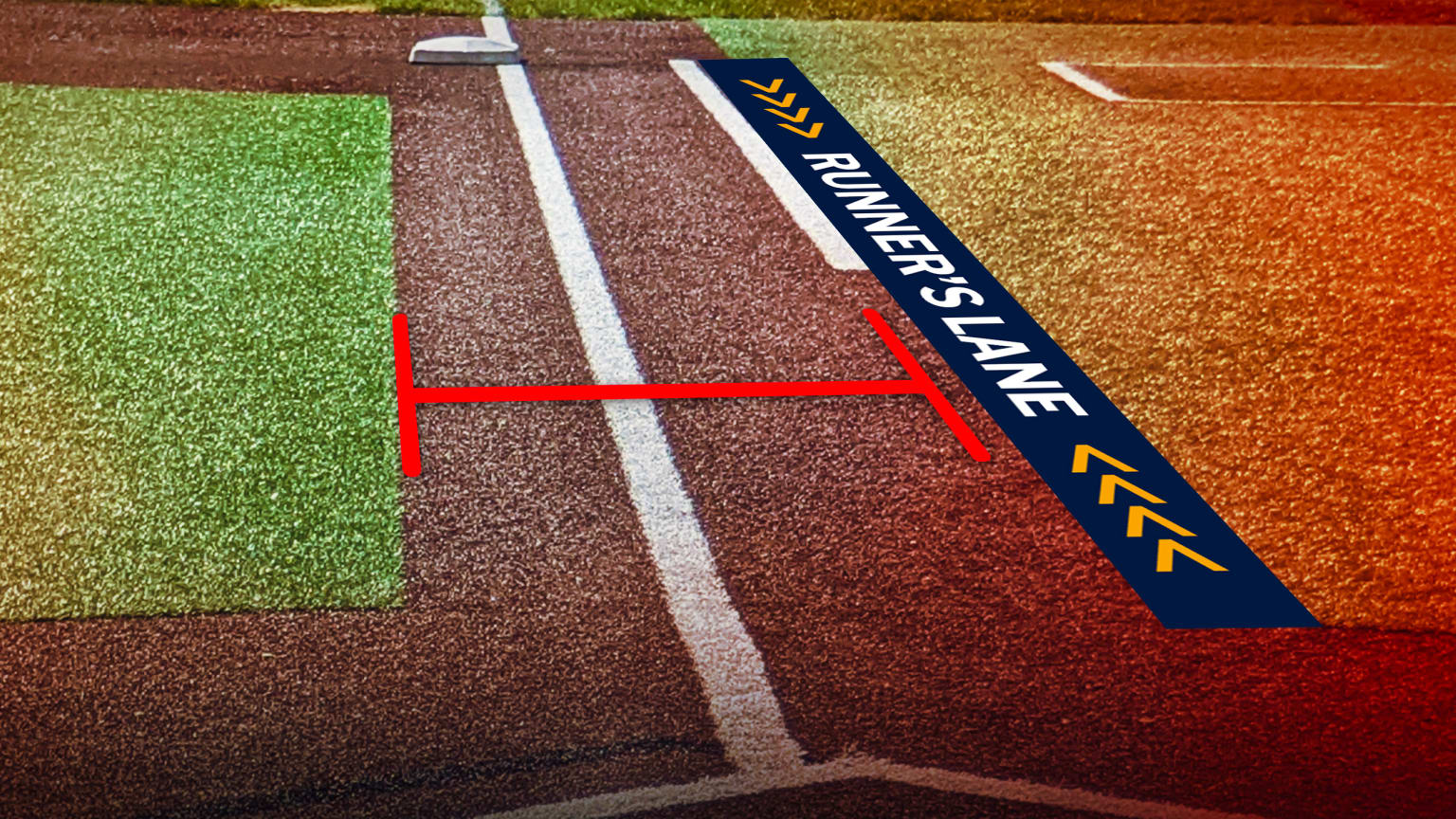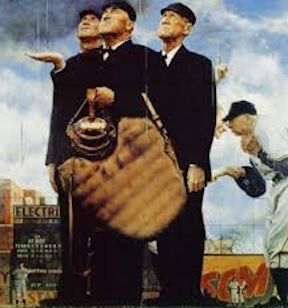
Rule Changes for 2024 in both OBR and NFHS Rulebooks
Both OBR and NFHS rulebooks have updates (in a few cases rather significant updates) in the form of rule changes for the 2024 season.
OBR Rule changes for 2024
1. Running lane is widened
Far and away the most noticeable rule change is widening the running lane that covers the last half of the distance (45 feet) between home plate and first base. The running lane (until 2024 updates changed it) marked a three-foot-wide path extending the last 45 feet of the path to first base, entirely in foul territory. The applicable rule is 5.09(a)(11). The new rule expands the three-foot-wide running lane by from 18 to 24 inches, nearly doubling the width of the running lane to from 54 to 60 inches wide.
The three-foot-wide running lane has been around for a long time. It first appeared in a baseball rulebook in 1858; in 1882 the National League mandated that the running lane be marked on the field (chalked on the path to first base) and the American League followed suit in 1885. Despite that, however, the rule has always been rather inconsistently called, and has been the source of bitter arguments on a great many occasions.
The 2024 rule change widens the running lane to include the dirt area in fair territory that lies between the foul line and the infield grass line that runs parallel to the foul line. The rule stipulates that this expanded area in fair territory be between 18 and 24 inches in all Major League ball parks, providing flexibility to accommodate variations in infield layouts. Furthermore, MLB is providing a grace period for parks to comply in cases where artificial turf makes alterations to the infield difficult.

The width of the running lane is nearly doubled and now includes areas in both fair and foul territories. This will help alleviate ambiguity that formerly crept in with the former rule that required runners to remain in foul territory until reaching first base, when “The batter-runner is permitted to exit the three-foot lane by means of a step, stride, reach or slide in the immediate vicinity of first base for the sole purpose of touching first base” [5.09(a)(11) Comment]. The rule has always been problematic due in large part to that little proviso that allows the runner to exit the running lane without penalty “in the immediate vicinity of first base.” Let’s all take a moment to define “immediate vicinity.”
The rule expanding the running lane also helps level the playing field for right-handed batters who will now have a far more direct path to first base without fear of violating the rule and being called out for interference. It is also hoped that the ease and directness of “dirt good, grass bad” will make it easier for umpires to uniformly apply the rule.
It’s important to note that this rather significant rule change alters almost nothing about judging running lane infractions except the width of the running lane. All other aspects of judging running lane interference as it’s details in remain in current and enforceable.
2. Pitching timing changes
2024 updates include a minor revision to the “pitch clock,” reducing the time between pitches with a runner (or runners) on base from 20 seconds to 18 seconds. Pitchers will continue to have the option to disengage the rubber, resetting the pitch clock, up to two times during an at-bat. There is no change to time restrictions with no runners on base, which remains at 15 seconds.
3. Circumvention of pitch clock
Another change addresses the way that some pitchers circumvent (or abuse) the pitch clock rule. In 2023 the pitch clock did not start following a dead ball until the pitcher was on the mound. This gave pitchers the ability to delay the start of the pitch clock by simply walking around the periphery of the mound. No longer. Starting in 2024 the pitch clock will restart following a dead ball (for example, foul ball, interference call, mound visit, whatever) as soon as the pitcher has the ball and play is ready to resume.
4. Mound visits
A rule change reduces the number of mound visits allowed from five to four per game. That said, an extra mound visit is available in the ninth inning in cases where the defensive team has zero visits remaining at the end of the eighth inning. Mound visits to address an injury, or in which a pitching change is made, do not count against the four allowed visits. As before, teams are allowed one additional mound visit for each extra inning played.
5. Pitcher who warms up must face at least one batter
A pitcher who takes the mound and begins to warm up must face at least one batter (and must also meet the requirements of the three-batter minimum rule). Evidently there have been cases where pitching changes were made after a pitcher began warming up, delaying play. There are exceptions to this rule in the case of an injury sustained (or revealed) during warm-ups, or an ejection.
NFHS Rule Changes for 2024
To view the full text of the NFHS bulletin outlining 2024 rule changes, including notes on rationale for each change, see NFHS Rule Changes - 2024.
Rule 1-6-1: Player Communication Equipment (New)
New rule clarifying how and where a player may wear a wristband. The rule makes clear that wearing wristbands is permitted, but specifies allowable color schemes. The band must be worn on the wrist or forearm, and pitchers may only wear a wristband on their non-pitching arm.
The penalty for noncompliance is that the umpire shall issue a team warning on the first violation. On a subsequent violation both the offending player and the head coach will be ejected from the game.
Rule 1-6-2: Player Communication Equipment (New)
New rule clarifying that one-way electronic communication devices are allowed between the dugout and the catcher for the purpose of calling pitches. While using the device, the coach cannot be outside the dugout or bench area (if no dugout).
Note that the communication device can only be one-way; that is, the player (catcher) cannot communicate back to the coach in the dugout. No other player besides the catcher would be allowed to use the device, nor the coach be allowed to communicate with any other player using such a device.
The penalty for violating conditions of the rule is a team warning to the coach. On subsequent violation, the offenders and head coach shall be ejected from the game.
Rule 3-2-5: Coaching Communication Equipment (New)
New rule that runs parallel to 1-6-2, specifying that the coach may use a one-way electronic communication device for the purpose of calling pitches. The rule reiterates that the coach may not use the device to communicate with any other player while on defense, nor with any team member while on offense. And again, while using the device, the coach may not be outside the dugout or bench area (if no dugout).
The penalty for violating conditions of the rule is a team warning to the coach. On subsequent violation, the offenders and head coach shall be ejected from the game.
Rule 10-2-3h: Umpire-In-Chief
Modification to the rule that removes the word “spectators” from the sentence: “Forfeit the game for prescribed infractions by spectators, coaches, players or team/bench personnel.”
The rule change codifies that umpires have no authority nor jurisdiction over spectators, and that handling problems with spectators is the responsibility of “game management,” meaning the hosting institution or school district.
Appendix: Suggested Speed-up Rules , After Put Outs (#3)
The 2024 update removes Item #3 from the list of suggested speed-up rules. The explanation is that Item #3 is an NFHS Softball rule book mechanic that needs to be deleted from the Baseball rule book.
Wrapping Up
For additional information and for guidelines on interpretations, see Baseball Rules Interpretations - 2024.

